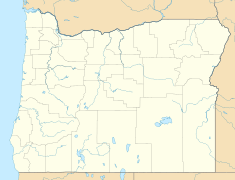Detroit Dam facts for kids
Quick facts for kids Detroit Dam |
|
|---|---|

Detroit Dam on the North Santiam River
|
|
|
Location of Detroit Dam in Oregon
|
|
| Country | United States |
| Location | Detroit, Linn County/Marion County, Oregon |
| Coordinates | 44°43′15.44″N 122°14′59.27″W / 44.7209556°N 122.2497972°W |
| Purpose | Flood control, power, irrigation |
| Status | Operational |
| Construction began | 1949 |
| Opening date | 1953 |
| Construction cost | $13,615,000 (1953 est.) equiv. to $149 million today |
| Owner(s) | U.S. Army Corps of Engineers |
| Dam and spillways | |
| Type of dam | Concrete gravity |
| Impounds | North Santiam River |
| Height | 463 ft (141 m) |
| Length | 1,523.5 ft (464.4 m) |
| Elevation at crest | 1,580 ft (480 m) |
| Reservoir | |
| Creates | Detroit Lake |
| Total capacity | 455,000 acre⋅ft (561,000,000 m3) |
| Active capacity | 321,000 acre-feet (396,000,000 m3) |
| Catchment area | 437 sq mi (1,130 km2) |
| Surface area | 3,500 acres (14 km2) |
| Maximum length | 9 mi (14 km) |
| Normal elevation | 1,569 ft (478 m) (full) |
| Power station | |
| Commission date | 1953 |
| Type | Conventional |
| Turbines | 2 x 100 MW Francis-type |
| Installed capacity | 100 MW |
The Detroit Dam is a huge wall of concrete built across the North Santiam River in Oregon. It's located in the beautiful Cascade Range, not far from the city of Detroit. The United States Army Corps of Engineers built this dam between 1949 and 1953.
When the dam was finished, it created a large body of water called Detroit Lake. This lake is about 400 feet (122 meters) deep and stretches for over 9 miles (14 kilometers). It has a long shoreline of 32 miles (51 kilometers), making it a great spot for outdoor activities.
Contents
Why Was Detroit Dam Built?
The Detroit Dam was planned as part of a big government effort to control floods. This plan was approved by a law called the Flood Control Act of 1938. Building the dam was delayed for a while because of World War II.
Main Purposes of the Dam
The dam was officially opened on June 10, 1953. It was built for several important reasons:
- Flood Control: To stop rivers from overflowing and causing damage to towns and farms.
- Power Generation: To create electricity using the force of the water.
- Navigation: To help boats move more easily on the river (though this is less common now).
- Irrigation: To provide water for farming, especially during dry seasons.
Other Benefits
Besides its main purposes, the Detroit Dam also helps with other things:
- Fishery: It supports fish populations in the lake and river.
- Water Quality: It helps manage the quality of the water.
- Recreation: The lake is a popular place for swimming, boating, and fishing.
The Detroit Dam works together with another dam called the Big Cliff Dam, which is located further downstream on the same river.
How Big is Detroit Dam?
The Detroit Dam is a very large structure that holds back a lot of water. Here are some interesting facts about its size and power:
Water Storage
- Drainage Area: The dam collects water from a huge area of 437 square miles (1,132 square kilometers).
- Lake Elevation: When the lake is completely full, the water level reaches about 1,569 feet (478 meters) above sea level.
- Usable Storage: The lake can hold about 321,000 acre-feet of water that can be used for different purposes. An acre-foot is the amount of water needed to cover one acre of land with one foot of water.
Generating Electricity
- Powerhouse: The dam has a special building called a powerhouse with two large machines.
- Power Capacity: These machines can produce 100 megawatts (MW) of electricity. That's enough power for many homes!
- Overload Capacity: For short periods, the dam can even produce up to 115 MW of power.
Images for kids




